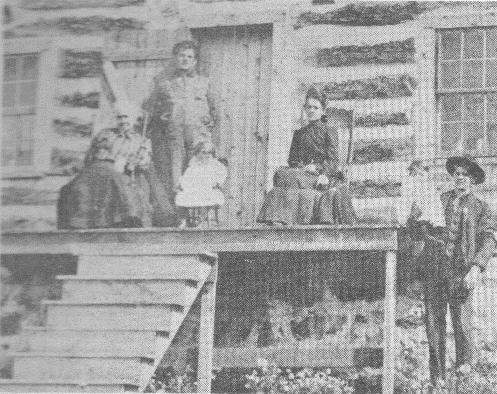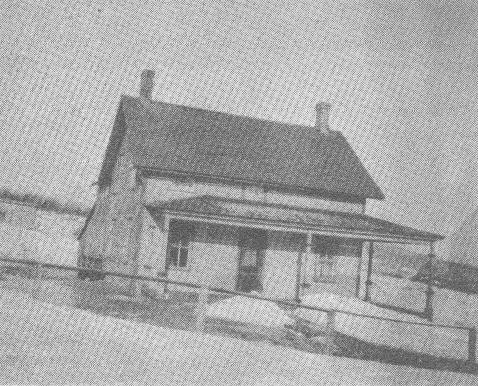
The early
days of St. Bernard's Parish found our little village well populated, because
many hands were needed to perform the tasks, which in later years were to
be taken over by machines and modern methods.
The people
lived in log houses, many of them built by the families who lived in them.
Ex. 1. Home of Mary Cordick. The village covered
a large area, with several small communities of houses located around the
village proper. These little communities grew around the source of employment.
The names that identified them were related to their industries
One of these
communities was called "82" after the small mine shaft in that area. About
twenty log houses once populated this busy area so that the miners were near
their work. When the supply of iron ore in "82" ran out, the original families
moved, but these houses were occupied for many years before being abandoned.
Some of the long forgotten names of these families were Frank Coates, Henry
Olyer, Joseph Pope, Peter Mousseau, Nelson Longto, Mr. LaPlant, Moses LaPan
and Les Manley.
The Junction
at bottom of Elbow Hill, was the name given the area between the present
railroad bed and the Badger Road to Saranac on the way to Chazy Lake. Several
families living here engaged in logging the then dense woodlands. Kilns
to make charcoal were also found here. Two names familiar to this area
were Fassett and Cataract.
Bradley Pond,
on the road to Ellenburg, was another busy community where a sawmill and kilns
to make charcoal provided employment. About twenty log houses provided living
quarters for the first families. Later, frame structures were built from
lumber sawed at the mill. George Atkinson was foreman of the mill operations
in the late 1890's. In the early 1900's the
mill was moved to Onchiota. Four of the frame structures, a store and three
houses were dismantled and rebuilt on Third Street in town. Ex. 2. Familiar family names were Atkinson, Cote
and Trombley.
Parishioners
from Chateaugay Lake and Chazy Lake traveled by horse and buggy in summer,
and sleigh in winter. Attendance at Mass and devotions was very good.
A fence around a pasture, where the present parking lot is located, provided
a place to hitch horses while the owners attended Mass. (refer No. 1 of
Church.)
The original
church was much smaller than the present building. The rectory, also, was
smaller. A large barn was needed for the horses and vehicles so necessary
for the priest.
Religion classes
were taught by women in their homes. About two weeks before First Communion
or Confirmation, children were excused from school to attend full day classes
at church, each child bringing his own lunch. Because of the many French families,
French was the major language used by the church. Catechism was taught
in French, but English was used in school.
At this time,
one doctor cared for everyone in the area. Since the nearest hospitals
were in Montreal, mine injuries, amputations, and operations were taken care
of in peoples' homes. Older people still retell of Wm. John Hart's leg amputation
on the kitchen table by Dr. Thurber resulting from a train injury. He was
father of Bernard Hart. Neighbors volunteered to help
with families and necessary chores during these emergencies. In 1898 an
epidemic of diphtheria caused the school to be closed, and all homes were
quarantined. Mr. C P. Pike, the town constable, would take orders for food,
which was purchased at the company store and paid for with coupon books.
He also delivered the food to the homes.
A second epidemic
in 1918, caused by influenza, again brought sickness and many deaths to the
village. It became necessary to have burials at night so that men employed
during the day could assist with transportation and graves.
At the turn
of the century, everyday living in Lyon Mountain was very different from today.
Log houses lined the narrow, rocky streets that were bordered by deep ditches
on either side. There was no indoor plumbing, no electricity for houses or
streets, and water was hauled in pails from wells, some of which were great
distances from the houses. A yoke made of wood and shaped to fit the shoulders
supported a pail on each side by hooks and made the task of carrying two
big pails of water a little easier. This task was not limited to men alone.
Out of necessity, women and children often had to help.
All houses
were rented from the company that operated the mines at the time. Most tenants
had a plot of land large enough to provide space for a garden and for barns
to house chickens and livestock. Large community pastures were provided, on
the outskirts of town, for the animals to graze. Hay for these animals
was harvested, mostly by hand, from every available space where grass could
grow. It was not uncommon for the cows and horses to break out of their pastures
and cause much damage to yards and gardens.
Walking was the main
way that people used to get from place to place around town. The walk
to the church much of the year was by way of Saranac Street and a plank road
around the east end of Church Pond, due to the wet conditions of the area
now known as Belmont Avenue. In due time, this area was to be filled by many
feet of ore sand washed down by the Separator Brook. This method was used
in place of storing the sand in piles as we see it today. For many years the
walk to church was over a path over this sand. So much sand would stick to
one's shoes and clothes and then be left on the bare wooden church floors.
The women who volunteered to clean the church were faced with the task of
sweeping the floors and shoveling the sand into buckets to remove it.
Baseball games,
picnics, bazaars and kitchen dances were some of the common pastimes and entertainments
of this era. The many residents of the area provided willing patrons for
the many bazaars held to raise money to help finance the building of the
new church.
Mrs. Victoria Robinson



